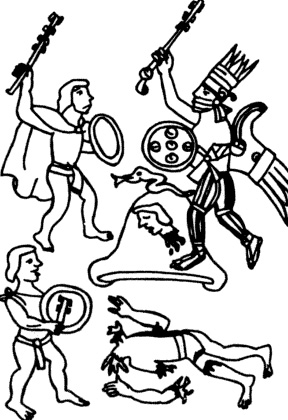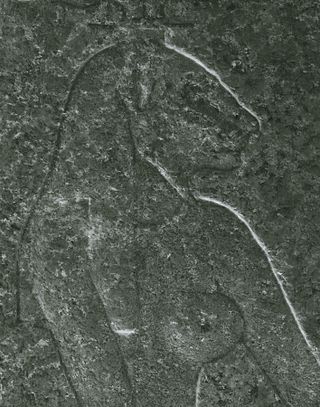
In ancient Greek religion and mythology, Artemis is the goddess of the hunt, the wilderness, wild animals, nature, vegetation, childbirth, care of children, and chastity. In later times, she was identified with Selene, the personification of the Moon. She was often said to roam the forests and mountains, attended by her entourage of nymphs. The goddess Diana is her Roman equivalent.

Diana is a goddess in Roman and Hellenistic religion, primarily considered a patroness of the countryside and nature, hunters, wildlife, childbirth, crossroads, the night, and the Moon. She is equated with the Greek goddess Artemis, and absorbed much of Artemis' mythology early in Roman history, including a birth on the island of Delos to parents Jupiter and Latona, and a twin brother, Apollo, though she had an independent origin in Italy.

Theia, also called Euryphaessa "wide-shining", is one of the twelve Titans, the children of the earth goddess Gaia and the sky god Uranus in Greek mythology. She is the Greek goddess of sight and vision, and by extension the goddess who endowed gold, silver, and gems with their brilliance and intrinsic value. Her brother-consort is Hyperion, a Titan and god of the sun, and together they are the parents of Helios, Selene, and Eos. She seems to be the same figure as Aethra, who is the consort of Hyperion and mother of his children in some accounts. Like her husband, Theia features scarcely in myth, being mostly important for the children she bore, though she appears in some texts and rare traditions.

In Aztec mythology, the Centzonhuītznāhua were the gods of the southern stars. These "four hundred" brothers appear in some versions of the origin story of Huītzilōpōchtli, the god of the sun and war. In these myths, the Centzonhuītznāhua and their sister Coyolxāuhqui feel dishonored upon learning that their mother, the goddess Cōātlīcue, had become impregnated by a ball of feathers that she had tucked into her bodice. The children conspire to kill their mother, but their plan is thwarted when, upon approaching their mother, Huītzilōpōchtli sprang from the womb—fully grown and garbed for battle—and killed them. Huītzilōpōchtli beheaded his sister Coyolxāuhqui, who became the moon. Huītzilōpōchtli chased after his brothers, who, in fleeing their brother, became scattered all over the sky.
Haumea is the goddess of fertility and childbirth in Hawaiian mythology. She is the mother of many important deities, such as Pele, Kāne Milohai, Kāmohoaliʻi, Nāmaka, Kapo, and Hiʻiaka. Haumea is one of the most important Hawaiian gods, and her worship is among the oldest on the Hawaiian islands. She was finally killed by Kaulu.
In Hawaiian mythology, Nāmaka appears as a sea goddess in the Pele family. She is an older sister of Pele-honua-mea.

Chang'e, originally known as Heng'e (姮娥), is the goddess of the Moon and wife of Hou Yi, the great archer. Renowned by her beauty, Chang'e is also known for her ascending to the Moon with her pet Yu Tu, the Moon Rabbit and living in the Moon Palace (廣寒宮). She is one of the major goddesses in Chinese mythology, Chinese folk religion, Chinese Buddhism, Confucianism, and Taoism. In modern times, Chang'e is the namesake of the Chinese Lunar Exploration Program.

In ancient Greek religion and mythology, Phoebe was one of the first generation of Titans, who were one set of sons and daughters of Uranus and Gaia. She was the grandmother of Apollo and Artemis, and the witchcraft goddess Hecate. According to myth, she was the original owner of the site of the Oracle of Delphi before gifting it to her grandson Apollo. Her name, meaning "bright", was also given to a number of lunar goddesses like Artemis and later the Roman goddesses Luna and Diana, but Phoebe herself was not actively treated as a moon goddess in her own right in ancient mythology.
The Triple Goddess is a deity or deity archetype revered in many Neopagan religious and spiritual traditions. In common Neopagan usage, the Triple Goddess is viewed as a triunity of three distinct aspects or figures united in one being. These three figures are often described as the Maiden, the Mother, and the Crone, each of which symbolizes both a separate stage in the female life cycle and a phase of the Moon, and often rules one of the realms of heavens, earth, and underworld. In various forms of Wicca, her masculine consort is the Horned God.

Mother Nature is a personification of nature that focuses on the life-giving and nurturing aspects of nature by embodying it, in the form of a mother or mother goddess.

Sól or Sunna is the Sun personified in Germanic mythology. One of the two Old High German Merseburg Incantations, written in the 9th or 10th century CE, attests that Sunna is the sister of Sinthgunt. In Norse mythology, Sól is attested in the Poetic Edda, compiled in the 13th century from earlier traditional sources, and the Prose Edda, written in the 13th century by Snorri Sturluson.

Amalur, also known as Ama Lurra was the goddess of the earth in the religion of the ancient Basque people. She was the mother of Ekhi, the sun, and Ilazki, the moon. She is also believed to not only be the goddess of the earth, but the earth itself.
Tala, based on Hindu goddess Tara, is the name of the goddess of the morning and evening star in Tagalog mythology. Her origins are varied depending on the region. Golden Tara, the Majapahit-era gold statue of Hindu deity Tara or Tagalog adoption Tala was found in 1918 in Agusan. The legend of Tala has very close parallels to legends among non-Filipino cultures such as the India tribes of Bihar, Savara and Bhuiya, as well as the Indianized Semang.

Rohini (रोहिणी) is a goddess in Hinduism and the favorite consort of Chandra, the moon god. She is one of the 27 daughters of the prajapati Daksha and his wife Asikni. As "the red goddess", she is the personification of the orange-red star Aldebaran, the brightest star in the Taurus constellation.
Willie's Lady is Child ballad number 6 and Roud #220. The earliest known copy of the ballad is from a recitation transcribed in 1783.

Mehit was an ancient Egyptian and Nubian lion goddess of Nubian origin.
Dewi Ratih, also known as Sang Hyang Ratih or Sang Hyang Semara Ratih, is a Hindu lunar goddess worshipped in Java and Bali. She is well known for her beauty and grace, thus she was also known as the Goddess of Beauty. Her myth is linked to lunar eclipses.
Shams, also called or Shamsum or Dhat-Ba' dhanum, is a sun goddess of Arabian mythology. She was the patron goddess of the Himyarite Kingdom. Her name meant 'shining', 'Sun', or 'brilliant'. She was the South Arabian equivalent of the North Arabian sun goddess Nuha.










